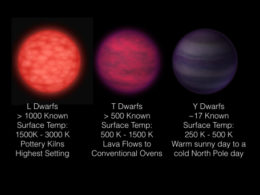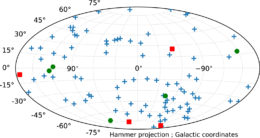We’ve tallied up a lot of the stars and substars that lie within our solar neighborhood, but we’re missing a key population: the coolest, dimmest substar dwarfs that lurk nearby. A citizen science study is now filling in this gap with the discovery of 95 new “backyard worlds.”
A Gap in the Census

Three types of progressively cooler brown dwarfs and their characteristics (click to enlarge). Y dwarfs are the coldest of substars. [NASA/JPL-Caltech/Backyard Worlds]
To better understand how stars and substars are distributed across this range, we’ve attempted to take a census of the bodies in our local solar neighborhood and observe their characteristics. The challenge in this lies on the brown-dwarf end: we’ve observed very few of the smallest, coldest substars in our solar backyard, because they’re so dim and hard to spot.
How to Spot a Hidden Substar
The key to finding these lurkers is all-sky surveying at long infrared wavelengths. The Wide-field Infrared Survey Explorer (WISE) is an ideal telescope for the task: this spacecraft has surveyed the entire sky in infrared 14 times over the span of a decade, providing us with a wealth of archived data. By searching for cool, dim objects that move quickly between successive images, we can identify the nearby brown dwarfs that we’ve been missing.
The catch? WISE’s imaging archive contains over 30 trillion pixels! Identifying small, dim, moving objects requires human eyes — a lot of them. It’s definitely time for crowd-sourcing.
A Job for 200,000 Eyes
The citizen science project Backyard Worlds: Planet 9 (which we’ve previously talked about) relies on more than a hundred thousand volunteers to examine WISE images and spot cool, nearby star and substar candidates — and after roughly three years of work, the project has now completed around 1.5 million classifications!

This gif illustrates how Backyard Worlds volunteers identify nearby, cold substars: by looking for objects that move (like the “dipole” and “mover” marked here) between successive WISE images. [Backyard Worlds]
Discoveries in the Data

Full-sky distribution of the 96 Backyard Worlds targets followed up with Spitzer. [Meisner et al. 2020]
- A number of Y-dwarf candidates. These are the coldest of substars, of which there are only a handful known.
- Two new worlds that lie within 30 light-years of the Sun.
- Two sources moving faster than 2” per year — a potential indicator that they’re relatively old objects with low metallicity.
- A T-dwarf substar that appears to be in a binary with a white dwarf.

Artist’s impression of a brown dwarf orbiting a white dwarf. [NOIRLab/NSF/AURA/P. Marenfeld, Acknowledgement: William Pendrill]
Citation
“Spitzer Follow-up of Extremely Cold Brown Dwarfs Discovered by the Backyard Worlds: Planet 9 Citizen Science Project,” Aaron M. Meisner et al 2020 ApJ 899 123. doi:10.3847/1538-4357/aba633

1 Comment
Pingback: From AAS NOVA: “Taking Stock of Backyard Worlds” | sciencesprings